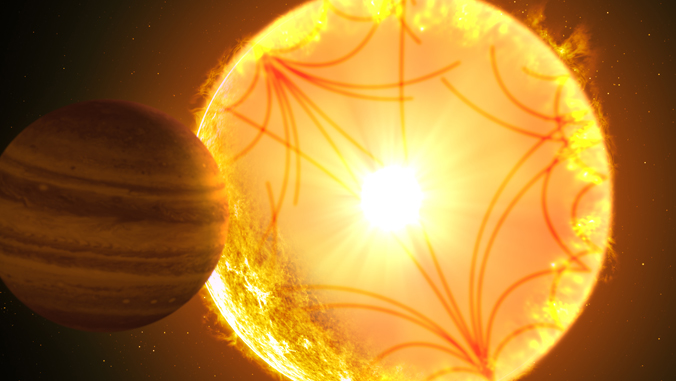
For the first time, astronomers have spotted an exoplanet with a decaying orbit around a star that resembles a future version of our Sun. The doomed world is destined to spiral closer and closer to its maturing star until they collide and the planet is obliterated.
The planet, Kepler-1658b, with a mass and size similar to that of Jupiter, is familiar to University of Hawaiʻi astronomers, who discovered it in 2019. The new findings, published in The Astrophysical Journal Letters, now show that the orbital period of the planet is slowly decreasing, this can help astronomers better understand the fate of planets in the Solar System, since the Sun is expected to eventually evolve in a similar manner.
“We had checked for evidence of this inward migration in the original discovery paper but could not definitively make that claim with only four years of data. therefore, it’s somewhat validating to see that our expectations were correct,” said UH Institute for Astronomy (IfA) alumna Ashley Chontos who is now a postdoctoral fellow at Princeton University. Chontos led the discovery of the planet as part of her dissertation research at UH Mānoa and is a co-author on the new study.
Kepler-1658b orbits its host star at only an eighth of the distance between our Sun and its closest planet, Mercury. For planets such as Kepler-1658b that are already very close to their stars, orbital decay looks certain to culminate in destruction.
Death-by-star
Measuring the orbital decay of exoplanets is difficult because the process is very gradual. According to the new study, Kepler-1658b’s orbital period is decreasing at the miniscule rate of about 131 milliseconds (thousandths of a second) per year, with a shorter orbit indicating the planet has moved closer to its star. The discovery offers new insights into the lengthy process of planetary orbital decay, by providing the first look at a system at this late stage of evolution. Death-by-star is a fate thought to await many worlds, and could be the Earth’s ultimate outcome billions of years from now as the Sun grows older.
“The ultimate fate of exoplanets is uncertain, but this system provides a crucial example for testing theories,” said Nick Saunders, a graduate student at IfA who co-authored the study. “By measuring the decay of the planet’s orbit, we gain valuable insight into how exoplanetary systems evolve and eventually come to an end.” Saunders is leading a search for more planets orbiting evolved stars for his dissertation.
- Related UH News story: Newly-discovered planets will be ‘swallowed’ by their stars, January 13, 2022
Steady observations
Detecting this decline in Kepler-1658b required multiple years of careful observation. The watch started with Kepler and then was picked up by the Palomar Observatory’s Hale Telescope in Southern California, and finally the Transiting Exoplanet Survey Telescope (TESS), which launched in 2018. All three instruments captured transits, the term for when an exoplanet crosses in front of its star, causing a very slight dimming of the star’s observed brightness. Throughout the past 13 years, the interval between Kepler-1658b’s transits has slightly but steadily decreased.
“We’ve previously detected evidence for exoplanets inspiraling toward their stars, but we have never before seen such a planet around an evolved star,” said Shreyas Vissapragada, a 51 Pegasi b Fellow at the Center for Astrophysics | Harvard & Smithsonian and lead author of the study.
The star has evolved to the point in its stellar life cycle where it has started to expand, just as our Sun is expected to, and has entered into what astronomers call a subgiant phase. The internal structure of evolved stars should more readily lead to removal of energy from planetary orbits compared to unevolved stars like our Sun. This accelerates the orbital decay process, making it easier to study on human timescales.
Additional co-authors on the study include IfA alumnus Sam Grunblatt and faculty member Dan Huber.

